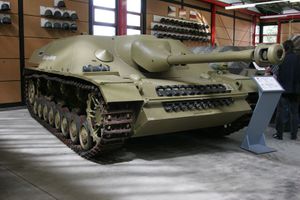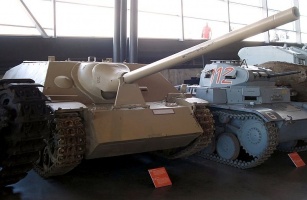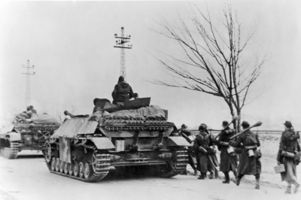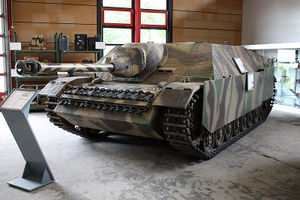JagdPz IV
JagdPzIV (Stock)
| 910500 價格 |
| 600 血量 |
| 24.1 / 24.2 公斤重量 |
- 車長
| 80/40/20 前/側/後,毫米車身裝甲 |
| 80/80/80 前/側/後,毫米砲塔裝甲 |
| 320 匹馬力引擎功率 |
| 40 公里/小時最高時速 |
| 32 度/秒迴轉速度 |
| 110 標準砲彈殺傷力 |
| 110 毫米標準砲彈穿透力 |
| 3.2 完全裝填的時間 |
| 44 度/秒砲塔迴轉速度 |
| 350 公尺可視範圍 |
| 310 公尺訊號範圍 |
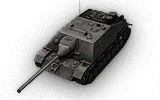
The Jagdpanzer IV is a German Tier VI Tank Destroyer.
The Jagdpanzer IV was conceived as a well armored Tank Destroyer, based on the Panzer IV chassis. Initially intended to mount the Pak 42 L/70, half of the Jagdpanzer's produced mounted the weaker, though combat proven, 7,5cm Pak 39 L/48. Eventually they were mounted with the Pak 42 and designated as Jagdpanzer IV L/70. Thanks to it's low silhouette and great guns, the Jagdpanzer IV exceeded in a Tank Destroyer role, especially in ambush and defense. Produced from January 1944 through March 1945, with a total of 1,699 tank destroyers manufactured. They saw combat on all fronts.
In truth, the Jagdpanzer IV is a great vehicle that unfortunately shares a tier with some monstrous, if not over powered vehicles. As such, the Jagdpanzer IV struggles to compete with them and thus comes across as underwhelming in comparison. That said, the 7,5cm L/70 that the Jagdpanzer mounts, is one of the most accurate guns in the game, and helps to create one of the most efficient snipers in the game.
The Jagdpanzer IV leads to the Jagdpanther.
Compatible Equipment
Compatible Consumables
Player Opinion
Pros and Cons
Pros:
- Excellent Camouflage value
- Great Mobility; 2nd best after the Hellcat
- Good frontal armour; low tier vehicles will struggle against it
- Good gun in the 7,5cm L/70; Excellent accuracy, great rate of fire, good penetration, good damage per minute
- Decent Gun Traverse Arc
Cons:
- Worst Penetration of all Tier VI Tank Destroyers; especially with "top gun" 8,8cm L/56
- Poor Alpha or Penetration dependent on which of the top guns is chosen; 7,5cm L/70 or 8,8cm L/56
- Poor Gun Depression; though average for Tier VI Tank Destroyers
- Poor View Range
Performance
The Jagdpanzer IV is widely considered the worst Tier VI Tank Destroyer, almost entirely due to the relatively poor guns it gets. Both of the top guns on (7,5cm L/70 & 8,8cm L/56) are under penetrating relative to all other Tier VI TD's, and in the case of the 8,8cm L/56, drastically under penetrating. This is unfortunate, as better penetration means better chance of inflicting damage, and in the case of these two guns, you must trade penetration for alpha or vice versa.
The 8,8cm L/56 only has 132mm of pen on it's AP round, and 171mm of pen on the APCR round. This is woefully inadequate for a tank destroyer that can see Tier VIII opponents. Ideally, the 7,5cm L/70 should be the main gun of choice despite it's low alpha damage. It is better penetrating and more accurate, all while inflicting good damage per minute. It will have no problem penetrating same tier and lower tanks, and stands a much better chance of penetrating Tier VII and VIII tanks.
When using the L/70, play the Jagdpanzer as a sniper, staying back in concealment and relocating as needed. It will fill this role better than any other Tier VI Tank Destroyer, thanks to it's accuracy and mobility. In the latter stages of the battle, don't be afraid to brawl with it when top tier, as the frontal armour is formidable and the speed of your gun will beat out most vehicles it comes across.
If you really want to use the 8,8cm due to the higher alpha and DpM, then focus on flanking as much as possible, as the standard AP round will bounce off numerous vehicles in Tier VI and higher, especially the further away you are. Try to situate yourself in areas where enemies will expose their side armour to you.
Historical Info
Development
After the Battle of Stalingrad, in September 1942, the Wehrmacht's arms bureau, the Waffenamt, called for a new standard for assault weapons; 100 mm of armor to the front, 40–50 mm on the sides, wider tracks, ground clearance of 50 cm, top speed of 26 km/h, and the lowest possible firing positions. The new Panzerjager ("tank hunter") design would be armed with the same 7.5 cm gun as fitted to the Panther: the Pak 42 L/70. Initially, a new chassis were planned, but that of the Panzer IV had to be used. Previous efforts to mount bigger guns on smaller chassis resulted in the Marder series as well as StuG IIIs. The Marder series were tall and had open crew compartments. The new design had a low silhouette and completely enclosed fighting compartment.
The Jagdpanzer IV used the Panzer IV chassis 7 (known as BW7), but the almost-vertical front hull plate was replaced by sloped armor plates. Internally, the layout was changed to accommodate the new superstructure, moving the fuel tanks and ammunition racks[clarification needed]. Since the Jagdpanzer lacked a turret, the engine which originally powered the Panzer IV's turret could be eliminated.
The new superstructure had 80 mm-thick sloped armour, which gives greater armor protection than a vertical armor of 100 mm. To make the manufacturing process as simple as possible, the superstructure was made of large, interlocking plates which were welded together.
Armament consisted of a 7.5 cm main gun, originally intended to be the PaK 42 L/70, but shortages meant that for the pre-production and the first production run, different older guns were used: the 7.5 cm PaK 39 L/48. These were shorter and less-powerful than the PaK 42.
Installing the much heavier PaK 42 meant that the Jagdpanzer IV was nose heavy, especially with the heavy frontal armor. This made them less mobile and more difficult to operate in rough terrain, leading their crews to nickname them Guderian-Ente "Guderian's duck". To prevent the rubber rims of the roadwheels from being dislocated by the weight of the vehicle, some later versions had steel roadwheels installed on the front.
The final prototype of the Jagdpanzer IV was presented in December 1943 and production started in January 1944, with the PaK 39 L/48 armed variant staying in production until November. Production of the PaK 42 L/70 armed variants started in August and continued until March/April 1945.
On August 19–22, 1943, after the Battle of Kursk, Hitler received reports that StuG IIIs performed better than Panzer IVs, within certain restraints of how they were deployed. It was thus intended to stop production of the Panzer IV itself at the end of 1944 to concentrate solely on production of the Jagdpanzer IV, but the Panzer IV was in production all the way until the end of the conflict, along with Jagdpanzer IV.
Variants
- Jagdpanzer IV with 7.5 cm PaK 39 L/43: a small number of these were built as the pre-production (0) series.
- Jagdpanzer IV with 7.5 cm PaK 39 L/48, official name Sturmgeschütz neuer Art mit 7.5 cm PaK L/48 auf Fahrgestell PzKpfw IV. Some 780 or so were produced in 1944.
- Jagdpanzer IV/70 (V) (Sd.Kfz.162/1) was one of two variants armed with the PaK 42 L/70 gun. Some 940 were built in 1944 and 1945. The (V) stands for the builder, Vomag.
- Jagdpanzer IV/70 (A) (Sd.Kfz.162/1) was the other PaK 42 L/70 armed Jagdpanzer IV. In order to send Pak 42 L/70-armed vehicles to the front as soon as possible, Hitler ordered an interim solution in July 1944. Alkett, a manufacturer of the StuG III, Alkett, was to immediately produce the Jagdpanzer IV to its own design. These differed in that its superstructure was mounted directly on the original Panzer IV chassis, and as such, lacked the sharp-edged nose of the Vomag variant. It was also taller. Only 278 were built in the period from August 1944 to March 1945. The (A) in the designation came from Alkett. This variant is also known as the Zwischenlosung: in translation, the "intermediate solution".
Minor modifications and improvements were made throughout the production runs of all variants, as well as several field improvements, the most common being the addition of armor side-skirts.
Originally, the Jagdpanzer IV/48's gun had a muzzle brake installed, but because the gun was so close to the ground, each time it fired, huge dust clouds would rise up and betrayed the vehicle's position, leading many crews to remove the muzzle brake in the field. Later variants dispensed with the muzzle brake.
Early L/48 and L/70-armed vehicles had zimmerit applied to the hull to protect against anti-tank grenades, but this was discontinued after about September 1944. Later vehicles had three return rollers rather than the original four, and adopted the twin vertical exhausts typical of the late Panzer IV series. Some late vehicles also had all-steel road wheels on the first couple of bogies on each side.
Combat history
The Jagdpanzer IV served in the anti-tank sections of Panzer and SS Panzer divisions. They fought in Normandy, the Battle of the Bulge, and on the Eastern Front (WWII). They were very successful tank-destroyers, but performed badly when used out of role as substitutes for tanks or assault guns, as most tank-destroyers were. In the later stages of the war however, they were increasingly used as tank substitutes, because there was often nothing else available. Romania received several Jagdpanzer IV tank-destroyers from the Red Army after the war ended. They were officially known as TAs T4s in the army inventory and were used until 1950. All German armor was scrapped in 1954.
One of the more notable Jagdpanzer IV aces was SS-Oberscharführer Roy from the 12th SS Panzerjäger Abteilung of the 12th SS Panzer Division. He was killed by an American sniper while looking out of the hatch of his Jagdpanzer IV on December 17 1944, during the Ardennes Offensive in Belgium.
After the war, West Germany continued the Jagdpanzer concept with the Kanonenjagdpanzer, but few other fixed-casemate self-propelled guns were built postwar.
Historical Gallery
Sources and External Links
| Light Tanks | |
| Medium Tanks | |
| Heavy Tanks | |
| Tank Destroyers | |
| Self-Propelled Artillery |
| USA | |
| UK | |
| Germany | |
| USSR | |
| China | |
| Japan |
